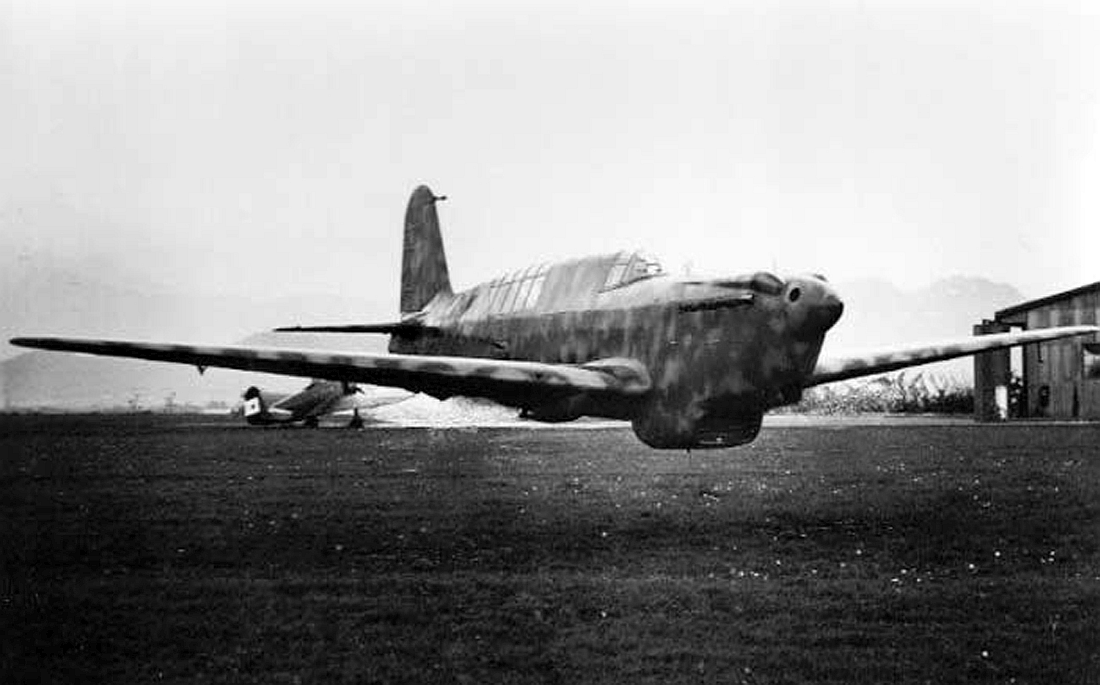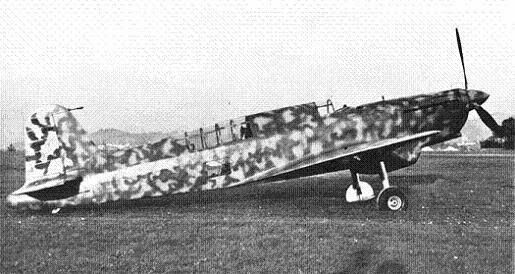Sabca S.47/Caproni Ca.335 MaestraleHi pilots,
Because Sturmovik it's still grows with new planes, this is probably one of my latest requests.
I must admit that I was surprised to reading about the Italian-Belgian cooperation and to tell the truth, I liked this project and not only because it is similar to Firefly F.Mk.I or Fairey Fulmar


.
Unfortunately, the plane never entered series production.
But Gentlemen, everything in the world of IL-1946 is possible, isn't it?
so I hope that also this plane will one day appear in the game and that Belgian A.F will finally have an airplane that will defend the sky over Belgium.

The Caproni Ca.335 Maestrale (Mistral) was an Italian single-engined two-seat fighter-bomber/reconnaissance aircraft of the 1930s. It was designed by Caproni to meet a requirement of the Belgian Air Force, with it being planned that the aircraft would be built under licence by the Belgian company SABCA as the SABCA S.47. Only a single aircraft was built, production plans being stopped by the German invasion of Belgium in May 1940.


SABCA S.47/Caproni Ca.335 Maestrale
Role Fighter-bomber/reconnaissance aircraft
National origin Italy/Belgium
Manufacturer Caproni/SABCA
Designer Cesare Pallavicino
First flight 16 February 1939
Number built 1
Developed from Caproni A.P.1
Sabca S.47/Caproni Ca.335 Maestrale Characteristics:
Type: single-engine monoplane fighter- bomber.
Country of origin: Italy.
Crew: 2
Length: 10'61m.
Wingspan: 13'20m.
Height: 3'20m.
Wing area: 23'80m2.
Empty weight: 2,250 kgs.
Maximum take-off weight: 3,350 kgs.
Power plant: 1 Hispano-Suiza 12 Ycrs, refrigerated by liquid, 12 cylinders in "V", 860 hp.
Maximum speed: 501 km / h.
Reach: 1,575 kms.
Service ceiling: 9,500 m.
Armament: 1x 20mm cannon. HS.404 in the nose, 3 machine guns Browning FN 7'62mm. (2 in the wings and 1 in the observer's cabin); up to 200 kgs. bombs underwing mountings.
Production: 1 copy.
 Caproni Ca.335 Maestrale
Caproni Ca.335 Maestrale


History:
Caproni, the Italian bomber king of WWI, tried around 1937 to exceed his business. At this time we see not only the sale of the Caproni-Bergamaschi Ca.135 medium bomber to Hungary and Peru, but also activities to sell the Ca.135 and the multi-purpose airplane Ca.310 to Belgium. The Belgian firm SABCA acquired the licence to sell these two planes. The Belgian Air Force, at that time, was still equipped with the old Fairey Fox two-seat light bomber biplane, but was looking to replace it with a modern design. Although Fairey had a strong foothold in Belgium in form of an own plant (Aviations Fairey), SABCA and Caproni in 1938 made a new agreement to develop a competitor to the contemporary Fairey design Battle.
Caproni got obliged with the construction of the airframe, while SABCA had to care for engine, propeller and armament, and so the Ca.335, called "Maestrale" (northwest wind, in French "Mistral"), was drafted by Caproni chief engineer Cesare Pallavicino. His performance is interesting by the way, he designed some particular aircrafts: Breda 15/18/19/27/33/39, CAB A.P.1/C.P.3/P.L.3/P.S.1, Caproni Ca.135/Ca.308/Ca.309, after the Ca.335 the Ca.331 and Ca.355. After the war he designed the famous scooter "Lambretta", before going to Argentina, where he created the I.Ae.30 "Namcu", a very fast two-engined fighter similar to the De Havilland "Hornet".
Pallavicino chose a clear cantilever low-wing design for a crew of two. The observer/rear gunner, sitting under a "greenhouse" glass roof in the rear fuselage, could also perform as auxiliary pilot, having a set of controls of his own. The construction contained of steel tubes, the fuselage was covered with aluminium plates, the wing with plywood. The whole back edge of the wing was covered with flaps, thus caring for short landing distances.
The aircraft was powered by the French Hispano-Suiza HS 12Y twelve-cylinder V-engine, delivering 860 hp and allowing to install a 20mm cannon firing through the propeller hub. Armament was completed by two wing-mounted 7,7 mm machine guns and a flexible one for the second crew member. A small bomb bay could carry two 50 kg bombs, while ten 10 kg bombs were to be mounted externally.
From the beginning, the aircraft was designed to serve as fighter, light bomber or reconnaissance aircraft. The airplane was completed at Caproni´s factory in Ponte San Pietro and flew for the first time on February 16th, 1939, with test pilot Ettore Wengi at the controls. In June that year, it was dismantled and sent by train to SABCA in Belgium. The next month, it was on display at the Salon International at Brussels.
After fitting the missing equipment, the flight tests continue in Belgium under the civil registration OO-ATH and painted with Belgian military roundels from September 19th on, with SABCA´s chief test pilot Paul Burniat at the controls. With a speed of 501 (other source says even 515) km/h and a ceiling of 10.500 m, the aircraft showed very fine performances. Nothing negative is said about the flight characteristics, so it can be assumed that the tests ran smoothly. On January 13th, it is demonstrated at Evere to the Belgian Militaire Vliegwezen/Aéronautique Militaire. The responsibles were quite delighted and told an option for 24 samples to be produced. On this occasion or another, the S.47 was also shown to foreign military delegations.
SABCA had purchased the manufacturing licence on November 30th, 1939. On January 1940 the Sabca S.40 was officially presented at Evere airfield to the Belgian authorities as well as to representatives of several foreign countries. On March 14th, 1940, the S.47 was flown together with the SABCA S.40 training aircraft to Orleans-Bricy (French test center), to be presented to officers of the French Armée de l'Air. There, because of bad weather conditions, the aircraft is slightly damaged in a landing accident, when it collided with a truck.
Neither in Belgium nor in France, could anything have been done to set up a production of the S.47 before the German troops arrived. In Orleans, the never-repaired S.47 fell in German hands on June 13th, 1940. Caproni made a request to get the airplane back, but the Germans (nobody can say who exactly or why) turned it down. The final fate of the prototype is unsure, one contributor says it was still seen in Orleans in April 1942, the other says mid-1943. Probably it was scrapped there, it was surely not brought to Germany.
One can say in mid-1940, the Regia Aeronautica had no interest in the type and did not support Caproni´s request. Also, the Ca.335 followed Belgian requirements, not Italian ones. Another difficulty surely was caused by the French inline engine, while Italy had nothing of its own to replace it and deliveries from defeated France were unsure or at least politically unwished.
Text and research by Holger Bergman - Additional information by "Ghiblie", Charles Mali, Luc Vanden Eynde and Daniel Brackx
Thank you for reading,
Greetings,
Piotrek
 Author
Topic: Sabca S.47/Caproni Ca.335 Maestrale (Read 3406 times)
Author
Topic: Sabca S.47/Caproni Ca.335 Maestrale (Read 3406 times)


